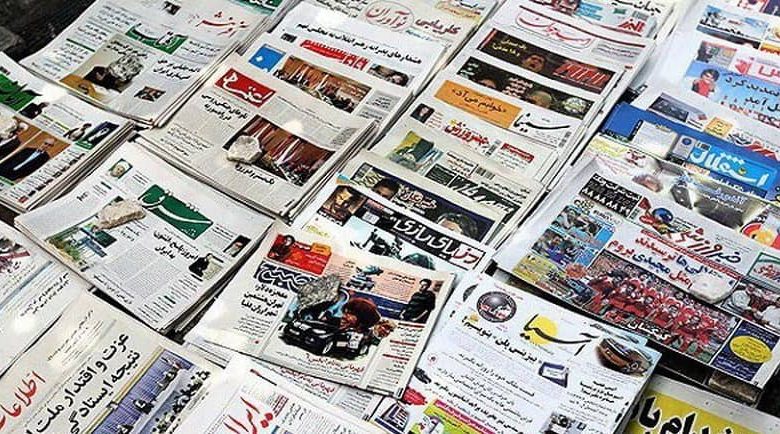A Glance at Iran’s State Media: Deepening Crisis, Dire Conditions, and a Looming Uprising

Written by
Mansoureh Galestan
Iran, IRGC, Iran Protests, state media, maryam rajavi, mek
In recent days, Iran’s state-run newspapers have once again highlighted various aspects of the country’s crises, the dire conditions faced by its people, the restive society, and the regime’s apprehension of another potential uprising.
In an article on May 28, the state-run Etemad daily warned about the “endless cycle of poverty.” “The impoverished family finds it difficult to endure this situation. However, they manage to tolerate the pressure to some extent, although it eventually lays the groundwork for rebellion, depending on the underlying cause of their poverty. If the circumstances are naturally occurring, the situation may be manageable. However, if it is due to government and societal inefficiencies, it could lead to migration and rebellion,” the paper wrote.
While regime officials lie about Iran’s economic meltdown and provide unrealistic statistics, state media acknowledge some aspects of the country’s real financial calamity. “In the past 17 years, starting from 2006, the number of impoverished individuals in our society has more than doubled. To provide a comparison, in 2006, the impoverished population in Iran was approximately 11 million people, whereas now it has surged to around 25 million people,” Etemad wrote in this regard, adding that “Instead of declining, the number of impoverished individuals has shown an alarming increase. Moreover, many individuals who have remained above the poverty line are now inching closer to it.”
“Simultaneously, the wealth disparity between different social classes has also widened. The Gini coefficient, a measure of income inequality, previously stood at around 37. However, it has steadily risen to approximately 39 and is now expected to have surpassed 40. The overall state of our society reflects this sentiment well. Notably, wealth accumulation is still heavily influenced by factors such as rental income, indicating that we are grappling with an extreme form of poverty,” the paper writes.
Watch and judge how a former official slams #Khamenei over the dire socio-economic crises in #Iran pic.twitter.com/qHEIBNT0P9
— NCRI-FAC (@iran_policy) May 9, 2023
Ebrahim Raisi’s government has been announcing statistics about the so-called “economic growth!” It also tries to downplay the current situation. In an article on May 29, the state-run Jomhuri-e Eslami newspaper tacitly rejected Raisi’s claims. “An ongoing concern that remains unclear is the discrepancy between the official inflation rate reported by statistical institutions and the inflation rate perceived by the general public in society. In August 2022, a survey conducted by the Majlis Research Center revealed that people experienced an average inflation rate of 86%. However, the Central Bank and Statistics Center announced point-to-point inflation rates of 46% and 51%, respectively, for the same month,” the paper wrote.
“This disparity between the official figures and the inflation felt by individuals highlights a significant discrepancy in perception and raises questions about the accuracy and reliability of the reported statistics,” it added.
But the situation is far from deplorable for many Iranians. According to Etemad’s article on May 29, “As food prices continue to rise rapidly, people are forced to reduce their food consumption. Consequently, the average calorie intake of individuals has declined by 11% over the years, nearing the critical threshold of 2,100 calories. Not only has the quantity of consumed food decreased, but the quality has also suffered. The amount of protein included in household diets has significantly declined.”
Yet, as the paper admits, “In a concerning trend, the government’s response to this situation seems inadequate. Despite a high inflation rate of 50%, the wage increase has only been around 20-27%. This disparity implies that as we enter the new year, we are heading toward a steep decline. The risk of increased poverty and growing inequality looms over us, even when oil revenues remain relatively favorable.”
Watch and judge how the regime is still struggling with #economic crises in the midst of #IranRevolution2022 pic.twitter.com/X0Z0dqqRv2
— NCRI-FAC (@iran_policy) December 18, 2022
From ordering prices to stop soaring and inflation to increase at a lower paste to vowing to eradicate absolute poverty in two weeks, Raisi and his administration’s officials have been making ridiculous promises about Iran’s worst economic crunch in a century. Therefore, Iran’s state media continue mocking them. “It is perplexing why authorities continue to present economic proposals that seem detached from the reality of Iran’s struggling economy and the daily hardships faced by its people,” the state-run Ebtekar Daily wrote on May 29. “Instead of making empty promises, it would be more beneficial if authorities exercised patience and carefully considered their plans. It is crucial to assess the feasibility and potential consequences of these proposals. Authorities think as if the economy is waiting for their order to pause the staggering 69% inflation rate!” the paper adds.
“It is deeply concerning that officials sometimes speak as if they are detached from the realities of living in this country, seemingly unaware of the hardships and livelihood challenges faced by the most vulnerable segments of society. They must understand these issues and take concrete actions to address them,” Ebtekar concludes.
https://www.ncr-iran.org/en/news/economy/a-glance-at-irans-state-media-deepening-crisis-dire-conditions-and-a-looming-uprising/

